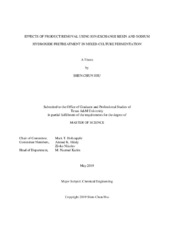| dc.description.abstract | In mixed-culture fermentations of lignocellulosic biomass, periodical product removal has proven to reduce product inhibition and thereby increase biomass digestion. Previously, ion-exchange resin (Amberlite IRA-67) was employed in countercurrent fermentation, and different amounts of resin loadings (10–40 g wet resin per 1.38 L total liquid volume) were studied. Using the pre-established culture (office paper and oven-dried chicken manure), this research used higher resin loadings (50, 60, and 80 g wet resin per 1.34 L total liquid volume). The 0.3-L resin column was sustained by COv2 (gas flow rate: 1.5 L/min). Compared to 30 g resin loading, when higher loadings were introduced, biomass conversion dropped by 0.05–0.09 g NAVSvdigested/g NAVSvfeed. Furthermore, the yield plateaued at resin loadings greater than 40 g. Overall, the optimal resin loading for both biomass conversion and acid yield was 30–40 resin loading per 1.34 L total liquid volume, which corresponded to 21.74–29.20 g wet resin/LvH2liq.
As indicators of digestibility, cellulase (Ctec3) and hemicellulose (Htec3) were used to saccharify pretreated corn stover. Shock pretreatment subjects biomass to a high-pressure pulse to enhance enzyme accessibility to cellulose and hemicellulose. It was found that 5.52 bar (abs) initial Hv2/Ov2 filling pressure generated a sufficiently high shock pressure to produce good digestibility. Sodium hydroxide is a potent alkali for pretreatment. Shock treatment (5.52 bar (abs) filling pressure) followed by moderate temperature (50℃) with 4 g OH–/100 g dry biomass NaOH concentration for 1 h is the recommended treatment condition.
The continuum particle distribution model (CPDM) simulates four-stage countercurrent mixed-culture fermentation from data obtained from batch experiments. Using the recommended pretreatment conditions described above, three different extents of pretreated corn stover were studied: (1) shock only, (2) NaOH only, and (3) shock + NaOH. As the nutrient source, sewage sludge was used together with raw or pretreated corn stover. Compared with raw corn stover, the CPDM map showed improvements in conversion and product concentration for NaOH treatment alone and shock + NaOH treatments; however, shock only made the corn stover less digestible. With shock + NaOH-treated corn stover, the model predicts the total carboxylic acid concentration of 36.1 g/L and conversion of 0.432 g NAVSvdigested/g NAVSvfeed at liquid retention time (LRT) of 35 day and volatile solid loading rate (VSLR) of 6 g/(L∙day). | en |


